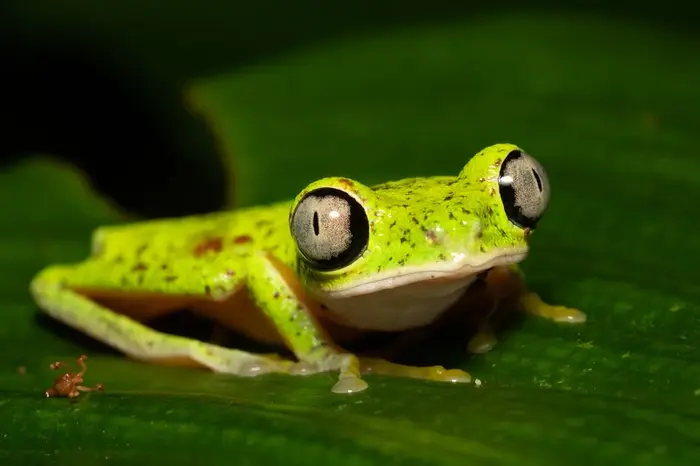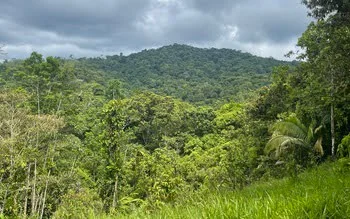The Lemur Leaf Frog: A Journey from Near Extinction to Recovery
How Conservation Efforts Rescued Agalychnis lemur from the Brink of Extinction in Costa Rica

Epic tale of the Lemur leaf frogs decline and recovery | January 27, 2025

In Central America’s rich tropical rainforests, the Lemur Leaf Frog (Agalychnis lemur) once thrived. A close relative of the famous red-eyed tree frog, the lemur leaf frog is known for its vibrant green coloration during the day and brown hues at night. This small, arboreal frog once inhabited the mid-elevation rainforests of Costa Rica, Panama, and northwestern Colombia. Its preferred habitats were at elevations between 440 and 1,600 meters, where it relied on the humid conditions of pre-montane rainforests to survive.
However, during the late 20th century, this species faced an unprecedented decline. The emergence of chytridiomycosis, caused by the chytrid fungus (Batrachochytrium dendrobatidis), devastated amphibian populations worldwide. The fungus attacks the skin of amphibians, impairing their ability to regulate essential functions like hydration and respiration. The Lemur Leaf Frog, like many species, suffered catastrophic losses. Once common in Costa Rica, its population plummeted by over 80%, pushing it to the edge of extinction.

In 2004, a small population of the Lemur Leaf Frog was discovered on an abandoned farm in Limón Province, Costa Rica, near Fila Asunción. This relic population provided a critical opportunity for conservation efforts. Its survival in isolation demonstrated the species’ ability to persist in small refuges, despite the pervasive spread of chytrid fungus across its range.
Recognizing the urgency of the situation, international conservation efforts quickly mobilized. Researchers from institutions like Manchester University, Bristol Zoo, and Nordens Ark established captive breeding programs to ensure the species' survival. These programs created carefully controlled environments to replicate the frogs’ natural habitats and provide stable conditions for breeding. Captive populations were developed as genetic reservoirs, safeguarding the species’ future while allowing for research into its ecology and conservation needs.

In Costa Rica, Brian Kubicki and his team at the Costa Rican Amphibian Research Center (CRARC) have played a pivotal role in the recovery of the Lemur Leaf Frog. Beginning in 2003, Kubicki launched a groundbreaking in-situ conservation program aimed at reintroducing and stabilizing populations of this critically endangered species within their natural habitat.
The initiative involved the creation of specialized breeding sites in the Guayacán Rainforest Reserve, an area selected for its ideal environmental conditions. Small ponds and strategically placed containers were introduced to mimic the frogs’ natural breeding environments. These semi-natural sites provided a safe space for the frogs to lay their eggs, while also protecting tadpoles and juveniles from predators and disease.
Over time, these artificial habitats proved successful. Within the first year, researchers observed breeding adults thriving in the surrounding vegetation and successfully reproducing. This milestone was significant—it marked the first documented case of a viable reintroduced population of Lemur Leaf Frogs in the wild. Kubicki and his team continued to monitor the sites, ensuring that the populations remained healthy and adapting their methods as needed to optimize the frogs’ survival.
An important component of the CRARC’s efforts has been to maintain genetic diversity and ecological balance in the reintroduced populations. The team carefully selected individuals for release to maximize genetic variation, which is crucial for the long-term viability of the species. Their work also involved educating local communities about the frogs’ ecological importance, fostering a sense of stewardship among those living near the reserve.
In addition to these in-situ efforts, the CRARC has contributed to global awareness about the plight of the Lemur Leaf Frog. By partnering with international conservation organizations and sharing their methodology, they have helped establish a model for amphibian conservation that can be applied to other critically endangered species facing similar threats.

Through a combination of meticulous planning, innovative techniques, and tireless dedication, the CRARC’s efforts have been a cornerstone of the Lemur Leaf Frog’s recovery. While the species remains critically endangered, the progress achieved at the CRARC offers a beacon of hope. It demonstrates that with the right resources, expertise, and collaboration, even species on the brink of extinction can be given a chance to recover and thrive in the wild.
These combined efforts have provided a lifeline for the Lemur Leaf Frog. Captive breeding programs have maintained genetic diversity, while in-situ efforts have allowed populations to reestablish in their natural habitats. While the species remains critically endangered, its recovery demonstrates the effectiveness of coordinated conservation strategies and underscores the importance of continued vigilance against threats like chytridiomycosis.
For those eager to see the Lemur Leaf Frog (Agalychnis lemur) in its natural habitat, staying at Brian Kubicki's guest house at the Costa Rican Amphibian Research Center (CRARC) offers a unique and unforgettable experience. Nestled within the lush rainforest reserve that Brian has dedicated to amphibian conservation, the guest house provides an ideal base for exploring the reserve’s incredible biodiversity. Guests have the rare opportunity to join a night tour led by Brian himself, where he shares his expertise and passion for amphibians while guiding visitors through the reserve in search of the elusive Lemur Leaf Frog and other fascinating species. To book a stay and reserve a spot on this exclusive tour, visitors can contact the CRARC directly through their website. This immersive experience not only supports ongoing conservation efforts but also allows wildlife enthusiasts to witness firsthand the beauty and resilience of one of Costa Rica’s most remarkable amphibians.

The story of the Lemur Leaf Frog is a testament to the resilience of nature and the potential of human intervention to reverse biodiversity loss. It highlights the value of dedicated conservation efforts and the critical need for global collaboration to protect vulnerable species from extinction. If you would like to read more about the lemur leaf frog, head to the lemur leaf frog species page to learn more about its range, behavior, habitat and more.
References
- Wikipedia contributors. (n.d.). Agalychnis lemur. In Wikipedia. Retrieved January 23, 2025, from https://en.wikipedia.org/wiki/Agalychnis_lemur
- Costa Rican Amphibian Research Center. (n.d.). Lemur Leaf Frog. Retrieved January 23, 2025, from https://cramphibian.com/lemur-leaf-frog/
- Conservation Leadership Programme. (2017). Lemur Frog Project final report. Retrieved January 23, 2025, from https://lemurfrog.wordpress.com/wp-content/uploads/2017/07/project-lemur-frog-project-final-report.pdf





